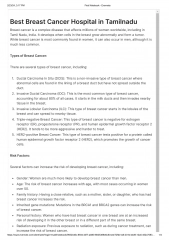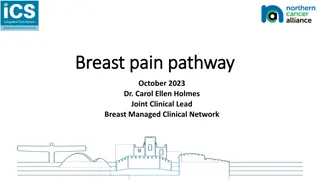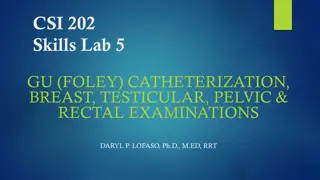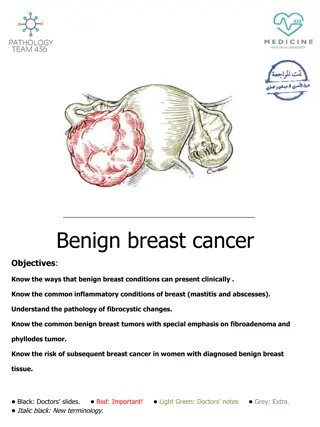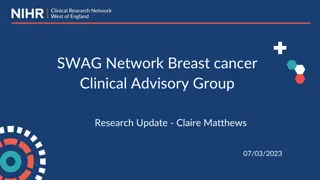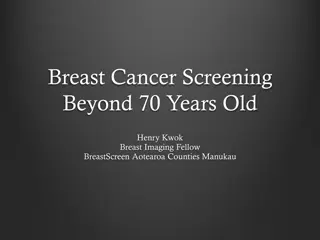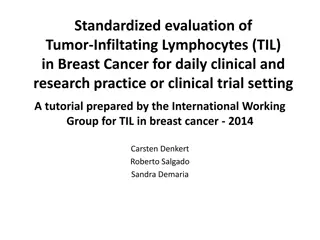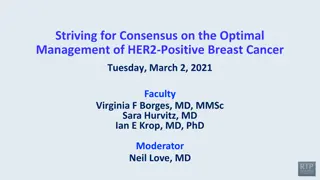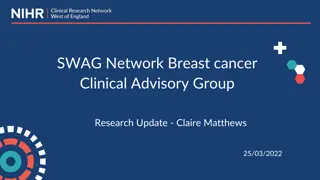Ontario Breast Cancer Screening Program Overview
The Ontario Breast Screening Program (OBSP) is a quality-assured, population-based breast cancer screening initiative administered by Cancer Care Ontario. It aims to reduce breast cancer mortality through early detection by providing biennial screenings for average-risk women aged 50-74 and annual screenings for high-risk women aged 30-69. With 167 sites across Ontario and over 4.1 million screenings conducted since 1990, the OBSP plays a crucial role in early cancer detection and treatment.
Download Presentation

Please find below an Image/Link to download the presentation.
The content on the website is provided AS IS for your information and personal use only. It may not be sold, licensed, or shared on other websites without obtaining consent from the author.If you encounter any issues during the download, it is possible that the publisher has removed the file from their server.
You are allowed to download the files provided on this website for personal or commercial use, subject to the condition that they are used lawfully. All files are the property of their respective owners.
The content on the website is provided AS IS for your information and personal use only. It may not be sold, licensed, or shared on other websites without obtaining consent from the author.
E N D
Presentation Transcript
Cancer Screening Update IDCA Meeting September 20, 2013
Overview Ontario s Cancer Screening Programs Ontario Breast Screening Program (OBSP) CR Mammography Technology Transition Project 2
Ontarios Cancer Screening Programs Ontario High Risk Breast Screening Program Ontario Breast Screening Program ColonCancerCheck Program 2008 2011 1990 Cancer Screening 2000 Announcement for Ontario Cervical Screening Program 3
Cancer Screening Goal Accelerate reduction in cancer mortality by implementing a coordinated, organized cancer screening program across Ontario 4
Organized Screening Program (IARC) Non OBSP Features OBSP OCSP CCC Recent Ontario/PEBC guidelines Initiatives to increase screening participation Routine recall Public Providers Follow-up of abnormal results QA Monitoring/evaluation Information system Yes Partial No Not for reproduction
OBSP Overview A quality assured, population-based breast cancer screening program administered by Cancer Care Ontario (CCO) for over 22 years. The goal of the OBSP is to reduce the number of deaths from breast cancer through early detection. Provides biennial breast screening services to average risk women 50-74 years and annual screening to women 30-69 years who are at high risk for breast cancer due to genetic factors, family or medical history. 167 sites across Ontario in hospitals and Independent Health facilities (IHFs), and two Screen for Life mobile coaches (NW and HNHB LHINs). Since the program was launched in 1990 the OBSP has provided over 4.1M screens to over 1.2M women age 50 and over and detected over 22,000 cancers, the majority in the early stages. For fiscal year 2012-13 the ministry allocated over $70M to support OBSP services for women across Ontario.
OBSP Quality Assurance Program OBSP s robust QA program sets forth a series of quality related requirements and standards for OBSP sites, technology, and personnel. These requirements and standards are intended to complement and add to existing guidelines and standards that govern professional practice and healthcare facilities (e.g., HARP Act, CPSO, CAR-MAP). Sites are obligated to participate in the OBSP s QA program. Most QA activity is funded via the OBSP mammography and assessment fees, but there are some exceptions: CCO pays for physics services for OBSP sites Sites are responsible for paying CAR-MAP fees 8
OBSP QA for Clinicians QA Process Description Apply to all clinicians affiliated with OBSP, including the Radiologist-in-Chief, Regional Breast Imaging Leads, reading radiologists, and medical radiation technologists (MRTs): Volume requirements (e.g., number of mammograms read per year) Note: does not currently apply to MRTs CME & education requirements CAR-MAP accreditation Annual peer-to-peer reports containing individual program outcomes (e.g., referral rates, cancer detection rates, positive predictive value, etc.), which can be compared to regional performance and national targets Radiologist-in-chief follows up directly with outliers to recommend corrective action (e.g., CME) Mammography image reviews conducted for each MRT by the Regional Breast Imaging Lead and Regional MRT Review frequency depends on past performance (i.e. MRTs requiring more attention will receive more frequent reviews) Education (e.g., positioning assistance) provided when appropriate See Program section for detailed process description Individual radiologists are confidentially notified of missed-at-screening cancers Credentialing and Retention Requirements Radiologist Outcome Reports MRT Image Reviews Interval Cancer Review 9
OBSP QA for Sites/Technology QA Process Description OBSP imaging standards exist for mammography, MRI and ultrasound (see Appendix for an example) Every OBSP site is required to be accredited through the Canadian Association of Radiologists Mammography Accreditation Program Imaging Standards CAR MAP Accreditation OBSP Physics Consulting Group assesses and maintains mammography image quality by verifying sites correct operation of the mammography system, image acquisition, processing, display and storage; the group also verifies that sites meet requirements of the regulations of the HARP Act and image quality of CAR-MAP Regions are required to have a mechanism in place to regularly monitor the quality of information captured on the OBSP Mammography Screening Record and entered into the Integrated Client Management System (ICMS) Physics Services Chart Audits 10
OBSP QA for Program QA Process Description Any case that is identified as a breast cancer diagnosed outside the OBSP before the client s next screening visit was due (based on her screening recommendation) will be reviewed by the OBSP, in order to classify post-screen cancers as either (1) missed at screening, (2) missed at diagnosis, or (3) true interval Quarterly reports are provided to the Regional Cancer Programs, highlighting their performance on several key operational and clinical indicators Follow up with outliers is conducted with support by regional and provincial clinical leads as required OBSP program evaluation reports are produced every two years and the results are made public Reports use an evaluation framework that has been aligned with national and international frameworks and indicators to facilitate comparison between programs (see Appendix for an example report cover) CCO Provincial Office staff conducts regular data quality audits of the data entered in ICMS to ensure that it is complete and accurate and to inform the regions of any areas for improvement Interval Cancer Review Regional Performance Reporting Program Evaluation Report Data Quality Review 11
CR Mammography Technology Transition Project 12
Chiarelli Study (CIHR Funded) Study Objective: To compare cancer detection rates, abnormal recall rates and positive predictive values for cancer among women screened in 2008 and 2009 between the digital cohorts (Computed Radiography (CR) or Direct Radiography (DR) systems) and screen film mammography (SFM) cohort Findings: CR had a statistically significant lower cancer detection rate than SFM DR and SFM s cancer detection rates were statistically equivalent Conclusion: OBSP data shows that CR mammography technology has inferior technical performance for image quality, compared to SFM and DR Publication Date: Tuesday, May 14 13
Project Background As a result of the findings from Anna Chiarelli s study and independent technical evaluation conducted by the Mammographic Physics Consulting Group, Ontario is moving towards standardizing Mammography equipment across the province (OBSP and Non-OBSP locations) The Ministry has approved one-time funds to replace all CR mammography technology across the province with DR mammography technology Cancer Care Ontario (CCO) will manage this transition on behalf of the Ministry CCO will be working closely with facilities and partners to replace CR mammography technology with DR mammography technology as quickly as possible 14
Project Update: Milestones Jun 2013 Jul 2013 Aug 2013 Sept 2013 Oct 2013 Nov 2013 Dec 2013 CR Site Eligibility and Contract Management 1st wave eligible CRs 2nd wave of eligible CRs Contracts with CR sites signed 100/103 CRs 103/103 CRs RFP closed Vendors selected Vendor pricing finalized Vendor Selection (RFP) Vendor/equipment selected by CR site Vendor/equipment approved by CCO CR Site informed of reimbursement amount CR Site Equipment Selection CR Site Reimbursement CR site reimbursed 20% CR site reimbursed 80% CCO informed of estimated installation date CR site screening on DR 96/103 DRs CR Site Live for Screening on DR 79/103 DRs Key Updates as of Sept 18, 2013 Legend: 77% of DR units currently installed (79/103 DRs) Complete Procurement Option # of Sites # of CRs In progress/upcoming Centralized 25 27 Independent 72 76 Total 97 103
Cumulative Number of DR units Installed Total DRs installed as of Sept 18th = 79 (based on sites estimated installation dates) 16
APPENDIX Examples of products that are part of the OBSP Quality Assurance Program 17
Radiologist Program Outcomes Report EXAMPLE (Individual Outcomes) 18
Radiologist Program Outcomes Report Where available, national standards are provided EXAMPLE (Aggregate Outcomes) 19


